Recognizing the precautionary principle
Thursday, November 27, 2025
Originally published in the Winnipeg Free Press on November 27, 2025.
Sio Silica’s recent Environment Act proposal shows that Manitoba is losing sight of past progress toward a harmonious relationship with nature.
The revival of this ridiculous drinking water risk from a rejected sand mine shines a light on our current regulatory failings in Manitoba, and the need for rejuvenation. A 50-year arc of increasing care for nature is in a steep descent as we are forced to consider proposals to contaminate aquifers for private profiteers.
What is the precautionary principal?
The precautionary principle, first adopted worldwide in the 1990s, should have kept us from wasting public discourse considering this absurd idea.
The precautionary principle became gold-standard guidance around the globe when it was adopted in the 1992 Rio Declaration on Environment and Development. In Manitoba’s proposed Environmental Rights Act it is explained as: If an activity raises threats of serious harm to the environment, precautionary measures should be taken even if it has not been fully established scientifically that the activity is harmful.
In this context, the proponent of the activity, rather than the public, should bear the burden of proof.

The two truths we need to understand our current situation are that healthy functioning nature is fragile and that capitalist interests are guided only by making money in whatever process is legal. In recognizing this, we can draw a straight line from the needs of nature to the increasing regulations we need to implement.
For decades, we as a global society have been trying to take better care of the Earth. The reality is that few places in the world have healthy, stable, natural ecosystems: the loss of plants and animals is occurring everywhere. The core of the solution is more environmental regulations and, in fact, environmental rights.
How did we get here?
Manitoba got its Environment Act in 1988 and, at the time, it was at the forefront of care for nature. But the arc from the birth of environmental care policy to the current disconnect from nature has left us in a bad place, with digital spaces largely owned and polluted with exploitative capitalist marketing. We need to talk about new environmental regulations for this generation and all our future kin.
Yet we’re hearing from our shiny new prime minister that we need to reduce red tape on projects as a way to build our nation, along with regulations being too costly from companies. We know the cost estimates of not acting on the biodiversity crisis and the climate crisis are astronomical and debilitating to all governments. But the scientific data unequivocally show we need more regulation, not less.
Meanwhile, Manitobans regularly tell pollsters they want more care for nature, to support our mental and physical well-being.
Which brings us back to sand. At the heart of environmental understanding the world recognized nearly 40 years ago was the precautionary principle.

Sio Silica’s plan to drill into aquifers and then suck sand out is risky as hell. To even consider this project flies in the face of the precautionary principle: there is a “threat of serious harm” to our water.
What's next?
After the Manitoba government rejects Sio Silica’s zombie sand mine plan, we need to immediately jump on passing an Environmental Rights Act. This is what Sio Silica has given. Manitoba: the immediate need for new guidance on the environment.
In 2015 and 2016, Manitoba introduced the Environmental Rights Act. The simple guidances are the precautionary principle, the polluter pays principle, the principle of sustainable development, the principle of intergenerational equity and the principle of environmental justice
The Environmental Rights Act did not become law as the NDP lost power in 2016. By itself , the act isn’t perfect, but it reinforces the guiding principles that we need right now. It offers us aspirations to live up to and a clear direction for how we should care for nature under capitalism.
Profiteers can continue to fill public messaging channels with misinformation and complaints about red tape or government controls, but good policy can still keep them in line.
The public discourse shouldn’t be questioning whether we will trade Sio Silica’s profits for our healthy water, but how our new Environmental Rights Act will protect us and nature against the corporate hunger for neverending profit.





